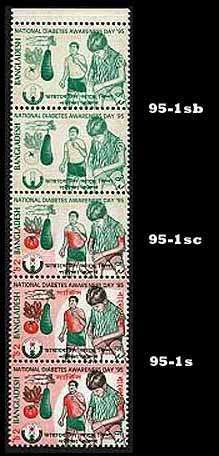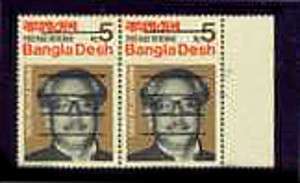
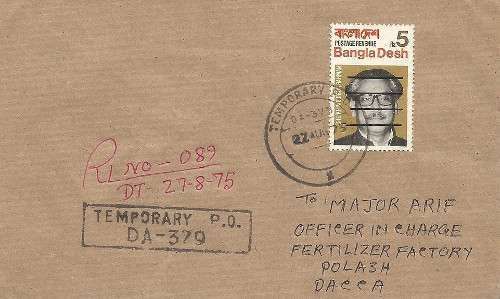
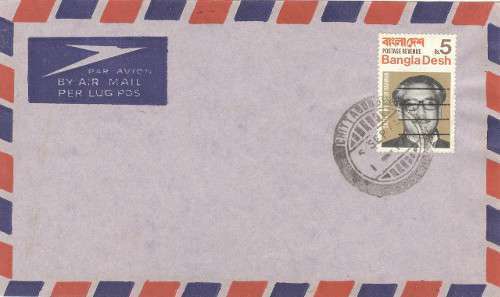
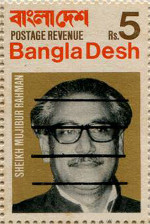
20 December 1971 - Bangladesh Liberated (Overprint on #1, 7 & 10, measuring 12mm horizontally)
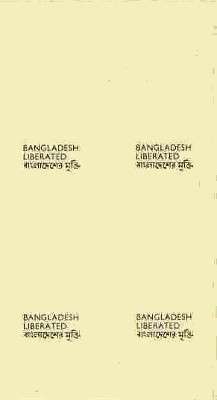
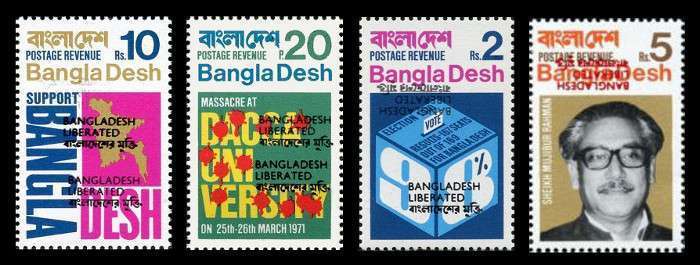
10 December 1973 - 25th Anniversary of the Universal Declaration of Human Rights 1973

It was believed that this SPECIMEN rubber-stamped overprint may not be genuine. It is also known on the 25 September 1974 set of two stamps for Bangladesh being a member of the United Nations. The two sets were offered by a dealer in India, known for dealing in dubious Bangladesh items. It has been learned that the government started stamping SPECIMEN on the stamps they gave to dignitaries at the First Day Ceremony as the dignitaries were using the unstamped stamps for postage. They started stamping SPECIMEN on them so they could not be used. It is the author’s opinion that the latter story is probably true and these may be genuine overprints.
73-4 10p Flame within a wreath – blue background
73-5 Tk.1.25 Flame within a wreath – purple background
2 Stamps.
25 September 1974 - Bangladesh in UNO
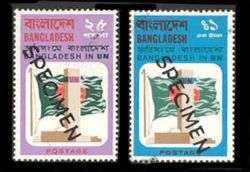
It is believed that this SPECIMEN overprint is a fake and was not applied by the Post Office Department. It was sold by a dealer in India, known for dealing in questionable Bangladesh material.
74-6 25p UN headquarters and flag – lilac and multi
74-7 Tk.1 Un headquarters and flag -blue and multi
2 stamps.
23 February 1980 - 75th Anniversary of Rotary International

80-1 40p Rotary emblem in red and black
80-2 Tk.5 Rotary emblem in blue and gold
2 stamps
Fake “SPECIMEN” overprint with a badly smudged rubber stamp at the bottom left of the images. The same overprint exists on the overprinted Rotary stamps of 1987.
16 May 1985 - Upa-Zila Election 1985 (Overprint on 29 April, 1978 Flowers of Bangladesh set)
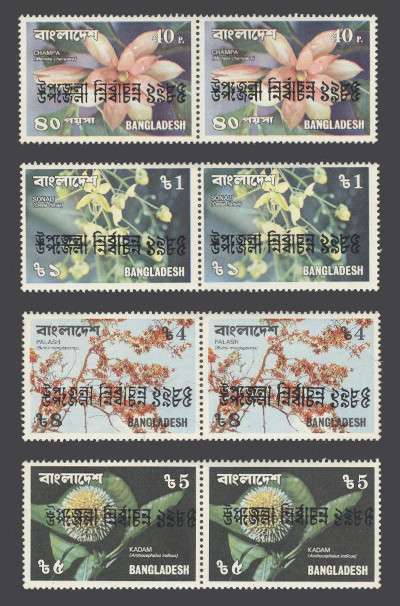
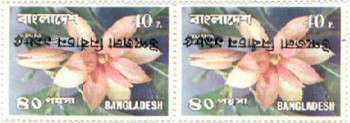
All of the above overprints are fake. These were not made by postal employees using genuine overprint. The overprint is slightly different from the genuine. The lower image has an inverted overprint.
85-5 40p Champa – Michelia champaca
85-6 Tk.1 Sonali (Pudding Pipe tree) – Cassia fustula
85-7 Tk.2.25 Krishnachura (Flamboyant tree) – Delonix regia
85-8 Tk.3.50 Shapla (water lily) – Nymphaea nouchali
85-9 Tk.4 Palash – Butea monosperma
85-10 Tk.5 Kadam – Anthocephalus indicus
6 stamps.
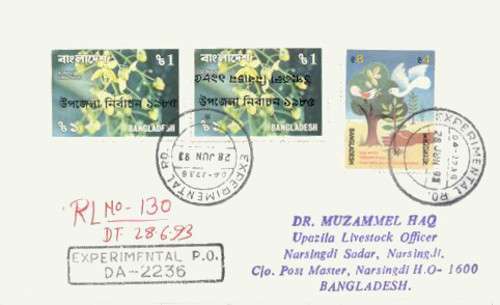
18 July 1985 - UN Decade of Women

29 Dec. - 3rd Bangladesh Scout Jamboree (Overprint on the Tk.5 value of the 22 January, 1978 First National Scout Jamboree stamp)
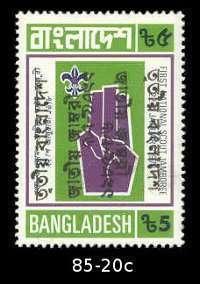
12 January 1987 - Rotary Conference for Development ’87 (Overprint on 23 February, 1980 75th Anniversary of Rotary International set)
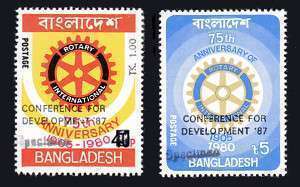
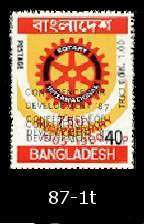
a. ovpt. shifted to the left, most of old denomination visible
b. obliteration only, no text ovpt.
c. ovpt. inverted
d. ovpt. double
e. ovpt. double but no obliterations
f. ovpt. double with “O” of “FOR” omitted, no obliterations
g. ovpt. double and shifted to the left. Denomination fully visible
h. ovpt. double with half of obliteration on each side of the stamp – enomination visible
i. ovpt. double with half obliteration and no new denomination
j. ovpt. double, “C’ and “D” not visible on left
k. ovpt double, one inverted
l. ovpt double, one inverted, bottom ovpt. shifted left
m. as “k” but “C’ and “D” only partially visible on bottom ovpt.
n. ovpt. double, one inverted, upper inverted ovpt. divided on each side of stamp – old denomination fully visible
o. ovpt. double, one inverted. Old denomination largely covered
p. ovpt. double, one inverted. Correct upper ovpt. on an angle, sloping to left – old denomination not covered.
q. ovpt. triple
r. ovpt. triple – one inverted – old denomination not covered
s. ovpt. triple – “4” not covered
t. Ovpt. triple – no obliteration over over old value
u. ovpt. triple – two inverted
v. ovpt. vertical – facing left
w. unissued ovpt. – horizontal thin line through 40p
x. test print – printed four times on stamp in green ink
87-2 Tk.5 Black overprint on blue and gold Rotary stamp
a. ovpt. inverted
b. ovpt. shifted left. “CO” and “DE” not visible
c. “O” of “FOR” missing
d. ovpt. double
e. ovpt. double, one inverted
f. ovpt. double, one inverted, one shifted left, the other right
g. ovpt. triple
h. as “g” but ovpt. shifted higher. “Conference” almost in line with central circle
i. ovpt for the 40p stamp
j. unissued ovpt for 40p stamp (87-1u)
k. as “j”, but top line of ovpt. missing
l. as “J” and “k” but top line totally missing.

2 January 1990 - National Population Day 1990

22 September 1990 - XI Asian Games, Beijing, ‘90

26 March 1991 - 20th Anniversary of Independence 1971-1991
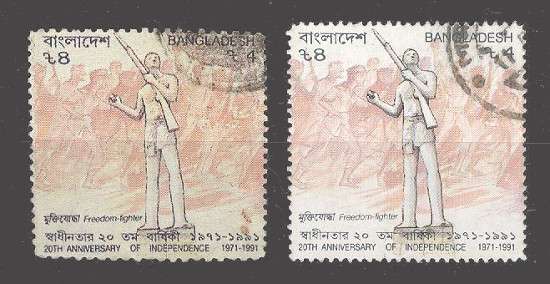
30 May 1991 - President Ziaur Rahman
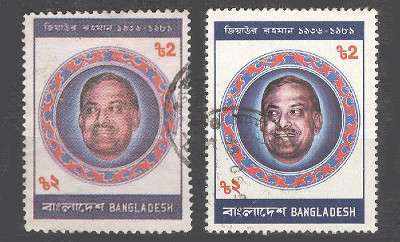
7 August 1991 - Poet Rabindranath Tagore
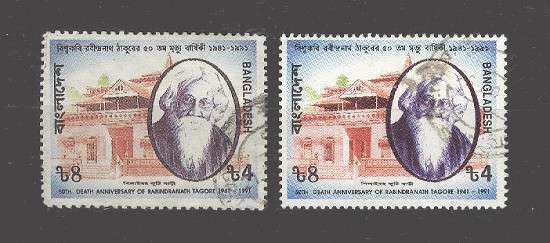
26 November 1991 - Archaeological Relics from Moinamati
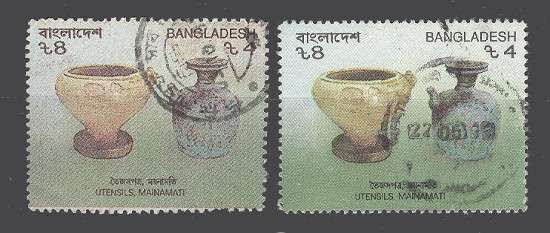
7 April 1993 - World Health Day '93

7 December 2003 - ICCDDR,B 25th Anniversary
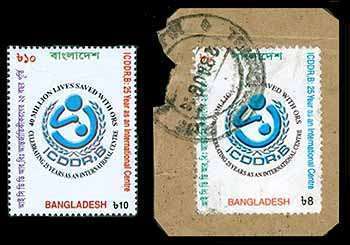
1995 (Unknown date) - SERVICE overprinted on definitive in red in Bengali
